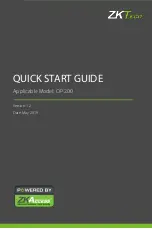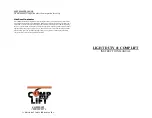
2.
Operation & Specifications
2 - 3
2.3 SAFETY INSPECTION
This Safety Inspection shall be carried out by the owner immediately prior to transporting
this machine.
This Safety Inspection shall also be carried out by the user
prior to use each day
.
The procedure is to carry out the following 14 checks in order as follows.
1. Remove the rear chassis covers by means of the two top twist-locks and the two lift-and-
turn catches at the sides. The cover is removed by sliding it backwards and upwards. Use
the central handle provided.
2. Ensure that the mast and jib are fully lowered. Remove the hydraulic oil filler cap and
check that the hydraulic oil level is correct. Oil should be visible on the dip stick. Top up as
necessary using hydraulic oil Viscosity Grade ISO 46.
3. Inspect the chassis area for oil leaks, loose parts, frayed cables and hoses and structural
damage etc. Check that all cable connections to the solenoid valves are intact.
4. Open the Inspection hatches on both sides of the upper mast cover. Check that the AC
mains cable is disconnected from the battery charger. Check the electrolyte level in each
battery cell. Top up as necessary with distilled water only.
5. Use the distilled water container supplied with the machine to fill the batteries to the correct
electrolyte level.
This is done by locating the battery topup valve behind the mast cover inspection door
(refer to figure 3) and connecting it to the valve fitted to the distilled water container tube.
The container can now be placed on top of the mast cover. Once both valves are securely
fastened together the air release cap located on the distilled water container can be
loosened, this will allow air to enter the container and start the release of distilled water.
The red flow indicator will start spinning (Refer to Fig 3) to indicate the distilled water has
started to flow into the batteries. The flow indicator will continue to spin until all batteries
are full, to verify batteries have been filled to the correct level each battery cell has its own
indicator that will become visible through the indicator window (Refer to Fig 3).
Once the battery fill has competed the air release cap can be tightened to prevent the
flow of distilled water from the container, it is now possible to disconnect the two valves by
pressing the release button located on the female valve (Refer to Fig 3).
Batteries should be examined for cracks, acid leakage and terminal corrosion. Take
corrective action immediately if either check fails.
Figure 3: Battery Fill & Valve
Water container
Battery Topup Valve
Container tube valve
Flow indicator
Water Level indicator
Air release
Summary of Contents for MB20J
Page 1: ...JANUARY 2018 01 00054 MB20 01 00071 MB26...
Page 2: ......
Page 4: ......
Page 6: ...NOTES...
Page 30: ...2 Operation Specifications 2 20 NOTES...
Page 31: ......














































